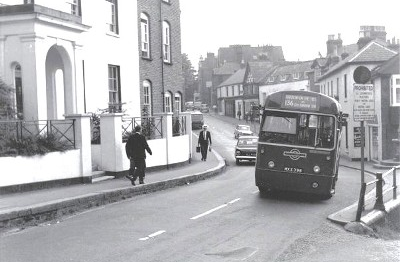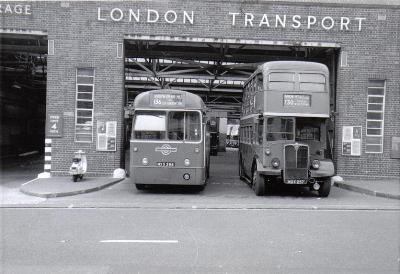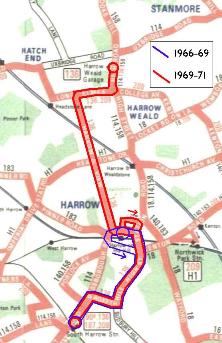|
|
 Red RF routes Red RF routes
Route 136
Page last updated 15 December
2014
The first all-new OMO RF route, introduced in the changes of
(Sunday) 7 Aug 66, the 136 demonstrated the feasibility of opening
up new territory with the improved economics of one-man
operation. The route was a success and the roads are all
still served.
More pictures of the 136 here.
RF421 in
Harrow-on-the-Hill village, October 1966.
Photo © Derek
Mulquin, Peter Gomm collection
Dates of RF operation
8 Aug 66 to 23 Jul 71
(total 5 years, all OMO)
Destinations
SOUTH HARROW
STATION and HARROW-ON-THE-HILL (Mon-Fri 8 Aug 66 to 28
Nov 69)
SOUTH HARROW
STATION and HARROW WEALD Red
Lion (Mon-Fri from 29 Nov 69, Sat from 15 May
71)
HARROW-ON-THE-HILL and
HARROW WEALD Red Lion (Sat 29 Nov 69 to 14 May
71)
 Reason for single-deck operation Reason for single-deck operationIntroduced in 1966, at which time one-man operation was only
permitted by single-deckers.
RF421 is seen leaving Harrow
Weald garage in 1971, after the 209 had been converted to Merlin
operation, but before the 136 converted in July of that year.
Photo © Mike Beamish
Route history
Following union agreement and the first OMO conversions in
1964, the improved economics of one-man operation led to the 136 as
the first all new suburban OMO route in 1966. Originally
designed to serve the area around Harrow College, the route was a
success and was extended in 1969 to Harrow Weald Garage to serve
Harrow View.
When extended, the original Monday to Friday operation was
supplemented by a Saturday operation between Harrow Weald Garage
and Harrow-on-the-Hill (by then referred to as Harrow Met
Station). The Saturday operation was extended to cover the
full route 10 weeks before conversion to MBS buses in July
1971.
 However, the changes were nearly earlier and more
dramatic. As part of a more ambitious scheme for Harrow that,
in the event, only achieved conversion of RLH route 230 to
MBS-operated H1 from 14 Jun 1969, there were plans to convert the
136 to a flat-fare route. Under the plans, it would have
become the G4 or (as revised) the H3, and taken on the
peak-hour extension of RT-operated 209 to Northwick Park.
That extension was finally achieved in 1985.
The ill-fated MBSs were replaced by SMSs in 1974 and Leyland
Nationals in 1979. A short spell of joint double-deck
operation with Metrobuses in 1986/7 preceded the loss of the
original South Harrow section to the 258, which still covers the
route today. The northern part via Harrow View was replaced
by the H15 in 1991.
July 1968, a year before
the end for Harrow Weald's RLHs, RLH57 shares a classic pose with
RF421, showing no Pay as you Enter sign.
Photo Peter Gomm
collection
Just a note on the history of the route number 136. For
many years in the 40s and 50s, this number was reserved by LT for
use in films and for other non-revenue uses - there
is for example a photo by Gerald Mead in John Hambley's 1954 book
of RT1849 showing route number 136 (including the offside
route plate) to the fictitious "St Johns Common". Prior to
the war, however, the 136 was a variant of the 36 to Grove Park, a
Bassom number that survived renumbering in 1934 and ran up to the
war.
 RF route
in detail RF route
in detail, with timing points SOUTH HARROW STATION, Northolt Road, Roxeth Hill, London Road,
Harrow High Street, Harrow
School, Peterborough Hill, Peterborough Road, Station Road,
College Road, HARROW ON THE HILL STATION. Return via Lowlands
Road, Tyburn Lane to Peterborough Hill (Mon-Fri, to 28 Nov
69)
SOUTH HARROW STATION, Northolt Road, Roxeth Hill, London Road,
Harrow High Street, Harrow
School, Peterborough Hill, Peterborough Road, Station Road,
College Road (return via Headstone Road, Kymberley Road, St Anns
Road to Station Road), Harrow Met
Station, Headstone Road, Harrow View, Headstone Goodwill to All, Harrow
View, Courtenay Avenue, Long Elmes
Courtenay Avenue, Long Elmes, High Road Harrow
Weald, HARROW WEALD Red Lion (Mon-Fri 29 Nov 69 to 14
May 71, Mon-Sat from 15 May 71)
HARROW Met Station to HARROW WEALD Red Lion
(Sats 29 Nov 69 to 8 May 71)
Frequency
| Year |
Mon-Fri |
Sat |
Sun |
| 1967 |
25 mins |
n/a |
n/a |
| 1969 |
30 mins |
n/a |
n/a |
| 1971 |
30 mins |
20-40 mins |
n/a |
From South Harrow Station, the route took about 10
minutes to Harrow on the Hill and a further 13 minutes to
Harrow Weald. The July 1967 timetable (before the
extension to Harrow Weald) is here.
RF allocation
PVR 1966: Mon-Fri 1 (+ 1 spare, RFs 421 and 315)
PVR 1969 (Nov): Mon-Fri 2, Sat 1 (+ 1 spare, RFs
421, 315 and 429)
PVR 1971 (May): Mon-Fri 2, Sat 2
Note: additional buses briefly provided cover for the above
three buses: RFs 326, 516 and 371 respectively. Trainers were
(at various times) RFs 317, 332, 368, 438.
Memories
Maurice Bateman hails from Harrow Weald and went to school on
RTs (but sports lessons involved travelling on lowbridge STLs,
before the RLHs arrived). He was there on 8 August 1966 for
the first day of operation of the 136 and reports as follows:
Indeed RF 421 was the normal bus on the
route but on the first morning, during its break at HD, a minor
incident at the garage meant that RF 315 had to take over the
service, so both buses ran on day one.
What happened was that RF 421 was fitted
with a rear blind so it showed only a large route number at the
front. On returning to HD for the morning meal break, garage staff
set about changing the blind. Unfortunately the stay for the blind
box glass did not hold up during the process and thus fell and
broke the glass. So RF 315 was wheeled up and took up service for
the rest of the day.
Re-creation
For details of the 40th anniversary operation of the route in
2006, click here.
|
|